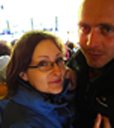




Copan (Honduras):
From La Palma, we took a bus to the frontier where we had to pay again the entrance fee for Honduras. I pointed out to the agent that we had already paid when we passed the frontier to reach El Salvador but he told me that we had to pay every time we cross the frontier! All is good to take some money!
A bus from Coatepeque brought us to La Entrada. From here, we took a "collectivo" or a taxi-van which can contain normally around 15 persons. We were 28 persons in this van!!! All stucked like sardines! And as a result, we had 2 flat tyres and hopefully the second one was when we just reached Copan because the van did not got 2 spare tyres on its roof!
In Copan, we went to visit the Mayan ruins, which are less known than the Tikal ruins in Guatemala but contain beautiful temples, altars and stelaes whose sculptured decorations of the buildings of Copán are some of the very finest surviving art of ancient Mesoamerica.
Copan was our only stop in Honduras. We decided not to go to visit the Bay Islands on the Caribbean Coast as that will extend considerably our trip (well from the 6 months planned at the beginning we are at 7 months already!). So from Copan we will go directly to Antigua in Guatemala.
- Drawing of the site. We did not buy a map of the site because that was to add to the expensive entrance fee. So I took a picture of the drawing and we could see where we were going easily!
- Panoramic view of the main plaza with the ballcourt building. The Mayans were playing a ball game but it is still not clear how they were playing it. Because we were here during the dry season, there was no grass as it is possible to see in some postcards,
- Panoramic view of the main plaza with the ballcourt building. The Mayans were playing a ball game but it is still not clear how they were playing it. Because we were here during the dry season, there was no grass as it is possible to see in some postcards,
- This large parrot or "guacamaya" was eating its breakfast with 3 others parrots. They were just at the entrance of the main plaza and we were lucky to see them so close because normally they are high in the trees,
- View of "la escalinata de los Jeroglificos" or "staircase of the hieroglyphs" which is protected by a canopy and which contains the most important hieroglyphs of all Mesoamerica,
- Inside the Acropolis.
- Inside the Acropolis.

















































